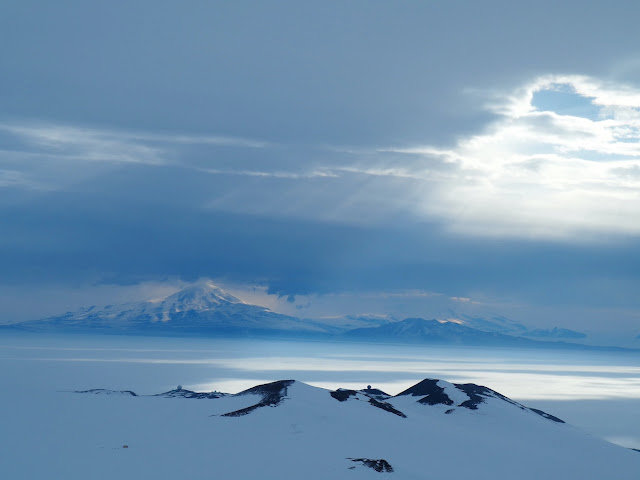View from Castle Rock, Ross Island across to the Transantarctic Mountains, in 2019. Image by Alex Aves.
Plastic has been found in the most unexpected places: in the deepest parts of the ocean, in the remote mountain air, in human blood. And now, it’s even been found in snow in Antarctica.
A new study published in The Cryosphere is the first to document snow-bound microplastics — tiny particles measuring up to 5 millimeters, about the size of a short grain of rice — in a part of the world that’s long been considered to be one of the last remaining wilderness, still largely unaltered by human activity. This study, however, illustrates the unlikelihood that there are any places on Earth that haven’t been touched by plastic.
The researchers collected freshly fallen snow from 19 sites across the Ross Ice Shelf in Antarctica and found 29 microplastic particles per liter of melted snow, which is a higher concentration than what other scientists have found in samples taken from the Ross Sea as well as Antarctic sea ice, the study says.
Lead author Alex Aves, a Ph.D. student at the University of Canterbury in New Zealand, said she was “very surprised” to find microplastics in the snow samples. Both she and her supervisor, Laura Revell, an associate professor of environmental physics at the University of Canterbury and co-author of the paper, said they actually expected not to find any plastic on the Ross Ice Shelf due to its remoteness.
“It really just shows that microplastics are everywhere,” Aves told Mongabay in an email.
“It adds another pathway for microplastics to enter the environment and shows that terrestrial environments are just as exposed as marine environments to our pollution,” she added. “Once microplastics enter the environment they become available to organisms present and can enter the food chain, which has negative implications on health including changes to growth rates, reproduction and general biological functions.”
The researchers identified 13 kinds of plastic in their samples, the most common being polyethylene terephthalate (PET), the plastic used to make synthetic clothing, food packaging and bottles for personal care products.
The researchers collected freshly fallen snow from 19 sites across the Ross Ice Shelf in Antarctica and found 29 microplastic particles per liter of melted snow, which is a higher concentration than what other scientists have found in samples taken from the Ross Sea as well as Antarctic sea ice, the study says.
Lead author Alex Aves, a Ph.D. student at the University of Canterbury in New Zealand, said she was “very surprised” to find microplastics in the snow samples. Both she and her supervisor, Laura Revell, an associate professor of environmental physics at the University of Canterbury and co-author of the paper, said they actually expected not to find any plastic on the Ross Ice Shelf due to its remoteness.
“It really just shows that microplastics are everywhere,” Aves told Mongabay in an email.
“It adds another pathway for microplastics to enter the environment and shows that terrestrial environments are just as exposed as marine environments to our pollution,” she added. “Once microplastics enter the environment they become available to organisms present and can enter the food chain, which has negative implications on health including changes to growth rates, reproduction and general biological functions.”
The researchers identified 13 kinds of plastic in their samples, the most common being polyethylene terephthalate (PET), the plastic used to make synthetic clothing, food packaging and bottles for personal care products.
They surmised that most of the plastic came from outdoor clothing and equipment used by scientists and other personnel at the nearby research stations — in fact, they found that the concentrations of microplastics were three times higher in samples taken close to the research stations when compared to other samples. However, other microplastics may have originated from destinations farther afield, traveling up to 6,000 kilometers (3,700 miles) before reaching this part of Antarctica, the study says.
There’s a growing body of research looking at how land-sourced microplastics can be ejected into the atmosphere. For instance, one study found that microplastics found in the ocean, roads and agricultural fields are swept up into the air through wind and sea spray, and circulate through the world in a similar way to the biogeochemical cycles of water or nitrogen. Mongabay - link - Elizabeth Claire Alberts - link - more like this (plastic pollution) - link
There’s a growing body of research looking at how land-sourced microplastics can be ejected into the atmosphere. For instance, one study found that microplastics found in the ocean, roads and agricultural fields are swept up into the air through wind and sea spray, and circulate through the world in a similar way to the biogeochemical cycles of water or nitrogen. Mongabay - link - Elizabeth Claire Alberts - link - more like this (plastic pollution) - link

No comments:
Post a Comment